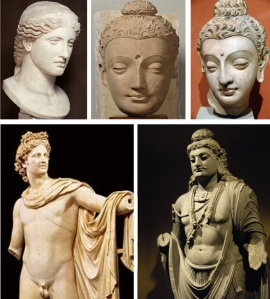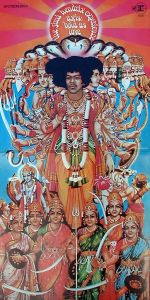“Oh, East is East and West is West, and never the twain shall meet”
-The Ballad of East and West by Rudyard Kipling, 1889.
This statement wasn’t true when Kipling wrote it in 1889, and it certainly isn’t true today. In fact, he penned his somewhat jingoistic statement so that he could refute it in the seldom quoted final two lines of the stanza – “But there is neither East nor West, Borders, nor Breed, nor Birth, When two strong men stand face to face, though they come from the ends of the earth!”
The cultures of East and West have been influencing each other as long as people have been able to walk out their front doors, and sometimes with quite notable results. While doing commerce with the Roman Middle East in the 2nd to 6th century C.E., South Asian traders from the Upper Indus river area and Kabul acquired a taste for Hellenistic art. They were Buddhists, but when it came to decorating their temples, they hired sculptors from the Roman Empire, creating the Gandhara style that was to influence the rest of Asia. In the hands of these sculptors, the Buddha took on the classical beauty and buff physique of the Greek gods. Putti and acanthus leaves abounded. In some sculptural groupings, the gentle Buddha was protected by an accompanying Hercules.

Top: Head of Artemis, 2nd cent. CE, Monumental Head of Buddha, stucco, 1-5 c. CE, Head of Buddha, limestone, 4-5th c. CE. Bottom: Apollo Belvedere, marble, c. 120 – 140 CE, After Leochares, copy of bronze original, Gandhara Bodhisattva, schist, 2nd-3rd cent.
As beautiful as these statues are in monochrome, it is important to remember that, when they were new, all of them, including the examples from Greece and Rome, would have been brightly coloured. In the West, for many of us of a certain age, first contact with the art of South Asia came in the form of a record cover for the LP Axis: Bold as Love by The Jimi Hendrix Experience. When this record was released in 1967, the Beatles were studying with the Maharishi in India, George Harrison had taken up the sitar, and all things Indian were considered hip.
It was the record executives, not Hendrix, who commissioned the cover. In it, a western artist has superimposed the faces of the members of the band over a mass-produced poster of a popular Indian painting, the Viraat Purushan-Vishnuroopam: Viraat Purushan – Vishnuroopam, print after painting. Hendrix was not particularly happy with the cover, because his music had nothing to do with the music of India. He would have preferred cover art that reflected his own Native American and African heritage. It remains, however, the image most often associated with him.
The use of the Viraat Purushan-Vishnuroopam for an rock cover may seem like cross-cultural plundering, but the kind of religious chromolithograph, often displayed on calendars, on which the cover image was based had its origins in the West.
The tradition of hanging paintings, prints and calendars on the wall was not indigenous to India. It was introduced by the British during their occupation of the sub-continent. The first artist to adapt Indian motifs to the popular print was Ravi Varma (1848-1906), painter to the royal household of the Travancore state of Kerala. After mastering the western technique of painting in oils, he set up one of the first lithographic presses in India. He was then able to produce domestically the calendars that previously had of necessity been printed in Germany.

Top: Vishnu, calendar print, Suryaand Devi, calendar print. Bottom: Film Still, The Bollywood Spongebob Extravaganza, 2009.
The most recent form of cultural hybridization to gain wide popular attention are the films of Bollywood. In its films, the Mumbai based Hindi cinema has been able to keep alive the light-hearted spirit and zany singing and dancing of the American musicals of the 1930s and 40s.
For this week’s extended session of the Open Studio, our model will be taking poses inspired by the art of India.
The evening will run from 7pm to 10pm. We will have short poses in the first hour, two medium-length poses in the second hour and a single long pose in hour three.
The fee for two hours is $10; for three, $15.
As always, you are welcome to attend for whatever combination of times works for you.
Hope to see you there!
~ Ken Nutt, Artist
Visit the Open Studio website – Click Here.
